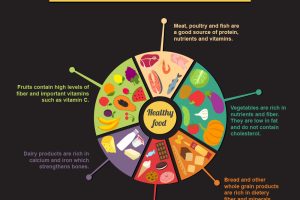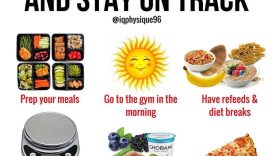Nutrition 101: Key Ingredients for a Healthy Lifestyle

Importance of Nutrition
Nutrition plays a pivotal role in maintaining overall health and well-being. The foods we consume directly influence our energy levels, mood, and even our ability to ward off illness. Think about it—when you fuel your body with nutrient-dense foods, you’re investing in long-term health. For example, integrating more fruits and vegetables into your daily meals can enhance your immune system, leading to fewer sick days and a more vibrant life.
- Nutrition 101: Key Ingredients for a Healthy Lifestyle
- Importance of Nutrition
- Benefits of a Healthy Lifestyle
- Macronutrients
- Understanding Carbohydrates
- Exploring Proteins
- Micronutrients
- Vitamins for Health
- Minerals for Wellness
- Hydration
- Importance of Water
- Other Hydrating Beverages
- Whole Foods vs. Processed Foods
- Nutritional Value Comparison
- Impact on Health
- Balanced Diet
- Creating a Nutritious Meal Plan
- Portion Control
- Diet and Exercise
- Fueling Your Workouts
- Recovery Nutrition
- Nutrition Myths
- Debunking Common Misconceptions
- Science-Based Facts
- Healthy Eating Habits
- Mindful Eating
- Meal Prep Tips
- Special Dietary Considerations
- Vegan and Vegetarian Diets
- Gluten-Free and Dairy-Free Options
- Nutrition for Different Life Stages
- Children and Adolescents
- Nutrition for Aging Adults
- XII. Grocery Shopping Tips
- Reading Food Labels
- Budget-Friendly Choices
- XIII. Eating Out Healthily
- Making Smart Menu Choices
- Portion Management
- XIV. Sustainable Eating
- Importance of Food Sustainability
- Eco-Friendly Food Practices
- XV. Conclusion
- Summary of Key Points
- Next Steps to a Healthier Lifestyle
Benefits of a Healthy Lifestyle
Embracing a healthy lifestyle brings a multitude of benefits that extend beyond just physical appearance. Here are some key advantages to consider:
- Improved Energy Levels: A balanced diet coupled with regular exercise boosts overall vitality.
- Mental Clarity: Proper nutrition enhances cognitive function, helping you focus better at work or school.
- Disease Prevention: A wholesome lifestyle significantly reduces the risk of chronic diseases such as diabetes and heart conditions.
For instance, after making dietary changes and committing to a regular workout routine, many individuals report feeling more energized and capable of tackling daily tasks with ease. These small adjustments can lead to profound impacts on life quality.
Macronutrients
Understanding Carbohydrates
Carbohydrates often get a bad rap, but they are vital for providing energy. They’re the body’s primary fuel source, especially during high-intensity activities. It’s important to choose the right types of carbohydrates. For example, whole grains, fruits, and vegetables are packed with nutrients compared to sugary snacks. Consider this: when I swapped refined carbs for whole grains, my energy levels soared, and my cravings decreased. Here are some carbohydrate sources to include in your diet:
- Whole grains: Brown rice, quinoa, and oats
- Fruits: Berries, apples, and bananas
- Vegetables: Sweet potatoes, carrots, and leafy greens
Exploring Proteins
Moving on to proteins, these building blocks are essential for muscle repair, immune function, and hormone production. Including a variety of protein sources in your diet can make a significant difference. From personal experience, switching to lean proteins like chicken and legumes has made meal prep easy and satisfying. Here’s a quick list of protein sources you might consider:
- Animal Sources: Chicken, turkey, fish, and eggs
- Plant-Based Sources: Lentils, chickpeas, tofu, and nuts
As you navigate your nutritional journey, remember that balancing carbohydrates and proteins is key to achieving optimal health.
Micronutrients
Vitamins for Health
While macronutrients fuel our bodies, micronutrients—vitamins and minerals—play a crucial role in maintaining overall health. Vitamins are essential for various bodily functions, from boosting immunity to supporting energy production. For instance, I discovered the benefits of Vitamin C after regularly including citrus fruits in my diet, which enhanced my resilience during flu season. Some key vitamins to focus on include:
- Vitamin A: Found in carrots and spinach, it’s great for vision.
- Vitamin C: Abundant in oranges and strawberries, it supports the immune system.
- Vitamin D: Sourced from sun exposure and fortified foods, it promotes bone health.
Minerals for Wellness
Equally important are minerals, which are involved in numerous processes, including maintaining fluid balance and bone structure. For example, since I started incorporating more magnesium-rich foods into my meals—like almonds and spinach—I’ve noticed improvements in my muscle recovery after workouts. Consider these vital minerals for your wellness:
- Calcium: Essential for strong bones, found in dairy and leafy greens.
- Iron: Crucial for oxygen transport, available in red meat and legumes.
- Potassium: Important for heart health, found in bananas and sweet potatoes.
By ensuring a diverse intake of vitamins and minerals, you’ll be setting a solid foundation for long-term health.
Hydration
Importance of Water
Now that we have explored the roles of vitamins and minerals, it’s essential to discuss hydration, starting with water—the most fundamental element for life. Staying well-hydrated helps regulate body temperature, supports digestion, and even enhances concentration. I remember feeling sluggish until I made a conscious effort to drink more water throughout the day; it was a game changer! To ensure adequate hydration, aim for:
- 8 glasses of water daily as a good baseline.
- Listen to your body: drink when you’re thirsty or if urine is dark in color.
Other Hydrating Beverages
While water is vital, other beverages can also contribute to your hydration needs. For instance, herbal teas and coconut water are excellent choices with added health benefits. Here are some hydrating options to consider:
- Herbal Teas: Chamomile or peppermint teas are caffeine-free and soothing.
- Coconut Water: A natural source of electrolytes, perfect post-exercise.
- Infused Water: Adding fruits like lemon or berries enhances flavor and adds nutrients.
By diversifying your fluid intake, you’ll not only quench your thirst but also nourish your body in delightful ways.
Whole Foods vs. Processed Foods
Nutritional Value Comparison
As we continue to explore nutrition, it’s crucial to differentiate between whole foods and processed foods. Whole foods, such as fruits, vegetables, whole grains, and nuts, are packed with essential nutrients and are generally devoid of artificial additives. I recall shifting my grocery shopping habits to prioritize whole foods, and the difference in my energy and mood was remarkable. On the other hand, processed foods often contain added sugars, unhealthy fats, and preservatives, diminishing their nutritional value. Here’s a quick comparison to consider:
- Whole Foods: Rich in vitamins, minerals, and fiber.
- Processed Foods: Often high in calories, low in nutrients, and may lead to unhealthy weight gain.
Impact on Health
The impact of our food choices on health cannot be understated. Whole foods support long-term wellness and can reduce the risk of chronic diseases. For example, including more fruits and vegetables in my diet not only improved my digestion but also enhanced my immune function. Conversely, a diet high in processed foods has been linked to various health issues, including obesity, heart disease, and diabetes. Consider these points:
- Whole Foods: Foster a healthy gut and improve heart health.
- Processed Foods: Can lead to inflammation and weight gain.
By making conscious choices towards whole foods, you’re not just feeding your body; you’re nurturing it for a healthier future.
Balanced Diet
Creating a Nutritious Meal Plan
Transitioning from understanding whole foods and processed options, the next step in your nutrition journey is crafting a balanced diet. A nutritious meal plan consists of a variety of food groups that provide essential nutrients. I’ve found that dedicating some time each week to meal prep has made a world of difference in maintaining healthy eating habits. Consider these guidelines when creating a meal plan:
- Variety: Include fruits, vegetables, whole grains, proteins, and healthy fats.
- Balance: Aim for a colorful plate to ensure a wide range of nutrients.
- Simplicity: Choose easy recipes to stay motivated and reduce cooking time.
Portion Control
Alongside a nutritious meal plan, portion control is fundamental to achieving and maintaining a healthy weight. It can be easy to overeat, especially with enticing snacks around. To make mindful eating a habit, I’ve started using smaller plates and pre-portioning snacks. Here are some simple tips for effective portion control:
- Start Small: Serve smaller portions to avoid overeating.
- Listen to Your Body: Pay attention to hunger cues and stop eating when satisfied.
- Avoid Distractions: Focus on your meal instead of screens, allowing for a more mindful eating experience.
By combining a well-thought-out meal plan with conscious portion sizes, you’ll be on your way to embracing a balanced diet for enhanced health and wellness.
Diet and Exercise
Fueling Your Workouts
Building on the foundation of a balanced diet, the relationship between diet and exercise is essential for optimizing performance and achieving fitness goals. Proper nutrition fuels your workouts, giving you the energy needed to push through those challenging sessions. I learned this firsthand when I started consuming a complex carbohydrate-rich snack before my runs, which noticeably boosted my stamina. Here are some key foods to include for pre-workout fueling:
- Bananas: Rich in carbohydrates and potassium, perfect for energy.
- Oatmeal: Provides sustained energy; consider topping it with fruits.
- Greek Yogurt: Packed with protein, great for muscle support.
Recovery Nutrition
Equally important is recovery nutrition, which helps your body heal and rebuild after exercise. After intense workouts, I prioritize refueling to restore energy levels and repair muscles. Key components of effective recovery nutrition include:
- Protein: Aim for a protein source, such as chicken, legumes, or protein shakes, to aid muscle recovery.
- Carbohydrates: Replenish glycogen stores with whole grains or fruits.
- Hydration: Don’t forget to hydrate; electrolyte-rich fluids can be beneficial.
Incorporating these strategies into your routine not only enhances performance but also supports overall health, paving the way for continued progress and well-being.
Nutrition Myths
Debunking Common Misconceptions
Continuing our exploration of diet and exercise, it’s vital to address common nutrition myths that can mislead well-intentioned individuals. One prevalent misconception is that all fats are bad for you. I used to believe this until I learned about healthy fats from sources like avocados and nuts, which are beneficial for heart health. Let’s debunk some other myths:
- Myth: Carbs make you gain weight. Fact: Whole grains and fruits are essential and can aid weight management.
- Myth: Skipping meals helps with weight loss. Fact: This can lead to overeating later; regular meals promote metabolism.
Science-Based Facts
It’s crucial to replace those myths with science-based facts for making informed decisions. For example, studies show that a balanced intake of macronutrients—including carbohydrates, proteins, and healthy fats—promotes optimal health and weight maintenance. Consider these important facts:
- Fiber is vital: It aids digestion and can prevent overeating.
- Hydration matters: Staying hydrated can enhance exercise performance and mental clarity.
By arming yourself with accurate information, you can build a nutrition plan based on facts rather than misconceptions, leading to a healthier lifestyle and better overall well-being.
Healthy Eating Habits
Mindful Eating
Having debunked common nutrition myths, it’s time to embrace healthy eating habits that can positively transform your relationship with food. One effective practice is mindful eating, which encourages awareness of the eating experience. I started this practice during meals, concentrating on flavors and textures, and it truly changed how I enjoy my food. To enhance your mindfulness while eating, try these tips:
- Slow Down: Take your time to savor each bite, which can prevent overeating.
- Limit Distractions: Avoid screens during meals to foster a better connection with your food.
- Listen to Your Body: Pay attention to hunger and fullness cues.
Meal Prep Tips
Another excellent strategy for healthy eating is meal prep, which can simplify your week and support nutritious choices. After I began meal prepping, I noticed a significant reduction in last-minute unhealthy food choices. Here are some practical meal prep tips:
- Plan Ahead: Set aside a specific day each week to plan meals.
- Batch Cooking: Prepare larger portions to save time and have meals ready to go.
- Use Clear Containers: Store pre-portioned meals in clear containers for easy access and visibility.
By incorporating mindful eating and effective meal prep into your routine, you’ll pave the way for lasting healthy eating habits that can lead to improved wellness and satisfaction.
Special Dietary Considerations
Vegan and Vegetarian Diets
As we delve into special dietary considerations, it’s essential to recognize the growing popularity of vegan and vegetarian diets. For personal reasons—including ethical and health considerations—I adopted a vegetarian lifestyle, and I’ve loved the variety it brings to my meals. Eating a plant-based diet doesn’t mean sacrificing nutrition. Key nutrient sources for vegans and vegetarians include:
- Legumes: Lentils, chickpeas, and beans provide protein and fiber.
- Nuts & Seeds: Almonds, chia seeds, and hemp seeds are great for healthy fats and additional protein.
- Whole Grains: Quinoa, brown rice, and oats are crucial for energy and nutrients.
Gluten-Free and Dairy-Free Options
Another consideration for many is the need for gluten-free or dairy-free options, often due to allergies or intolerances. I remember when a friend of mine shifted to a gluten-free diet; it opened up a world of wholesome, gluten-free grains like quinoa and buckwheat. For those needing to avoid gluten and dairy, consider these recommendations:
- Gluten-Free Grains: Rice, quinoa, and corn are naturally gluten-free.
- Dairy Alternatives: Almond milk, coconut yogurt, and cashew cheese can satisfy cravings without dairy.
- Label Reading: Always read labels to avoid hidden sources of gluten and dairy.
By understanding these dietary needs and incorporating diverse food options, anyone can maintain a balanced and satisfying meal plan that fits their lifestyle.
Nutrition for Different Life Stages
Children and Adolescents
Transitioning from special dietary considerations, it’s crucial to address nutrition tailored for different life stages, starting with children and adolescents. Proper nutrition during these formative years lays the foundation for a healthy life. For example, when I became a parent, I focused on providing nutrient-dense foods to ensure my kids have the energy they need for growth and learning. Key nutritional focuses for children and adolescents include:
- Calcium: Essential for strong bones, found in dairy products, fortified plant milks, and leafy greens.
- Iron: Vital for energy and cognitive development, sourced from lean meats, beans, and spinach.
- Healthy Fats: Important for brain development, available in avocados, nuts, and seeds.
Nutrition for Aging Adults
As we shift to the nutritional needs of aging adults, it’s important to adapt diets to maintain health and vitality. My grandparents often shared how their dietary needs changed as they aged, requiring more focus on nutrient-dense foods that support digestion and heart health. Key nutritional considerations for aging adults include:
- Fiber: Aids digestion and prevents constipation, found in whole grains and fruits.
- Protein: Necessary for maintaining muscle mass, sources include lean meats, legumes, and dairy.
- Hydration: Older adults may not feel thirsty; promoting water intake is crucial for overall health.
Understanding and addressing these nutritional requirements at different life stages ensures everyone receives the nutrients they need to thrive throughout their lives.
XII. Grocery Shopping Tips
Reading Food Labels
Having explored nutrition across various life stages, it’s time to tackle grocery shopping tips to make healthier choices while navigating the aisles more efficiently. Understanding how to read food labels is the first step in making informed decisions. I remember initially being overwhelmed by all the numbers and terms, but I soon learned to focus on key areas. Here’s what to look for on food labels:
- Serving Size: Check the serving size to understand calorie and nutrient amounts.
- Ingredients List: Opt for items with fewer and recognizable ingredients.
- Nutritional Content: Aim for products high in fiber, vitamins, and minerals, while low in added sugars and unhealthy fats.
Budget-Friendly Choices
In addition to reading labels, sticking to a budget is essential for many households. After implementing a few strategies, I found that healthy eating doesn’t have to break the bank. Consider these budget-friendly tips:
- Plan Your Meals: Create a weekly menu to make focused shopping lists.
- Buy in Bulk: Purchase grains, nuts, and legumes in bulk to save money.
- Seasonal Produce: Buy fruits and vegetables that are in season for better prices and freshness.
By combining label literacy with budgeting savvy, anyone can navigate grocery shopping with confidence, making healthier and more economical choices for their families.
XIII. Eating Out Healthily
Making Smart Menu Choices
Moving from grocery shopping to dining out, making healthy choices at restaurants can sometimes feel challenging. However, with a few strategies in mind, you can enjoy your meals while maintaining your health goals. I recall a time when I would impulsively order the fanciest dish on the menu, often laden with calories. Now, I approach menus more thoughtfully. To make smart choices, consider the following:
- Look for Grilled Options: Choose grilled rather than fried items to keep meals lighter.
- Appetizers as Mains: Opt for appetizers or side dishes, which often provide smaller, more balanced portions.
- Request Dressings or Sauces on the Side: This allows you to control the amount added to your meal.
Portion Management
In addition to smart menu choices, practicing portion management is key to maintaining a balanced approach while eating out. I found that simply being aware of portion sizes has helped me enjoy dining out without overeating. Here are some effective tips for portion control:
- Share Dishes: Split an entrée with a friend or family member to enjoy a variety of tastes without overindulging.
- Ask for a Takeaway Box: Request a box at the beginning of your meal and set aside half to take home.
- Focus on Sides: Choose healthier sides like salads or steamed vegetables instead of fries or heavy starchy dishes.
By implementing these strategies, you can savor the dining experience, enjoy delicious food, and still adhere to your health goals.
XIV. Sustainable Eating
Importance of Food Sustainability
Transitioning from healthy dining out experiences, let’s delve into the importance of sustainable eating. Today, more people are recognizing that our food choices can significantly impact the planet. I became more conscious of this after learning about how food production contributes to environmental issues like climate change and biodiversity loss. Adopting sustainable eating practices not only benefits our health but also supports the planet. Consider these points about food sustainability:
- Reduces Carbon Footprint: Choosing local and seasonal foods can lower greenhouse gas emissions.
- Supports Local Economies: Buying from local farmers fosters community growth and reduces transportation costs.
- Conserves Resources: Sustainable farming practices often use less water and preserve soil health.
Eco-Friendly Food Practices
Embracing eco-friendly food practices can make a significant difference in fostering sustainability. After incorporating some of these practices into my own life, I’ve felt more connected to my food and its sources. Here are some eco-friendly strategies to consider:
- Plant-Based Meals: Including more plant-based meals in your diet can reduce resource use and emissions compared to meat-heavy diets.
- Composting: Start composting food scraps to minimize waste and enrich your garden soil.
- Minimize Plastic Use: Bring reusable bags and containers when shopping to reduce single-use plastic waste.
By integrating sustainable principles into your eating habits, you contribute to a healthier planet while enjoying the benefits of nourishing, eco-conscious foods.
XV. Conclusion
Summary of Key Points
As we wrap up our journey through the world of nutrition, it’s important to reflect on the key points we’ve covered. From understanding macronutrients and micronutrients to embracing sustainable eating practices, each aspect plays a vital role in achieving overall health. Personally, this comprehensive approach has helped me make informed food choices that benefit both my body and the environment. Here’s a quick recap:
- Balanced Diet: Incorporate a mix of proteins, fats, and carbohydrates.
- Mindful Eating: Practice awareness during meals to foster better digestion and satisfaction.
- Sustainable Eating: Choose local, seasonal foods to reduce your environmental impact.
Next Steps to a Healthier Lifestyle
Now that you’re equipped with knowledge about nutrition, it’s time to take actionable steps toward a healthier lifestyle. Begin by setting small, achievable goals. Perhaps start meal prepping or try incorporating more plant-based meals once a week. Remember to:
- Stay Informed: Continue learning about nutrition and sustainable practices.
- Experiment: Don’t be afraid to try new foods and recipes—find what works best for you!
- Engage with Community: Seek out local farmers’ markets or community-supported agriculture programs to connect with your food sources.
With these steps, you’ll be on your way to crafting a fulfilling and sustainable journey toward health and wellness. Enjoy the process and celebrate each positive change you make!





